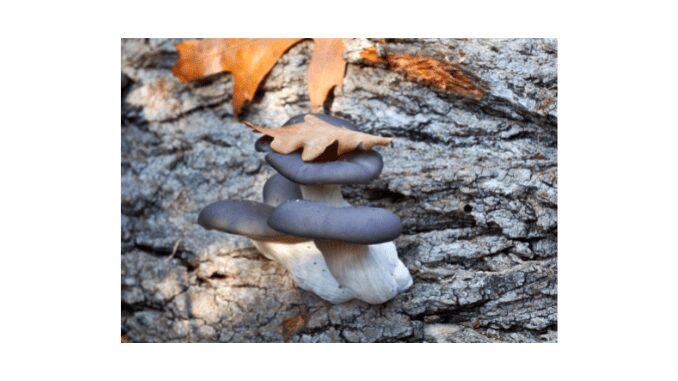Know in one minute about Blue oyster mushrooms
|
Introduction
Blue oyster mushrooms (Pleurotus ostreatus var. columbinus) belong to the family Agaricaceae which grows in shelf or bracket-like layers. It is the third major cultivated mushroom worldwide after the white button mushroom and shiitake mushroom. These mushroom-secreted enzymes decompose dead organisms or other waste to absorb nutrients (1).
This mushroom grows in cluster form and grows faster than other edible mushrooms. It starts with a deep blue that turns gray as they age. It has a meaty texture, sweet flavor, and high nutritional value. This mushroom can be used in place of meat because it is more affordable and readily available than animal proteins (2).
Geographical distribution
Native to central and Western Europe, this mushroom grows well in cooler temperatures (3).
Classification
Kingdom- Fungi
Phylum -Basidiomycota,
Class- Basidiomycetes
Family- Agaricaceae.
Nutritional value of blue oyster mushroom
This mushroom is a rich source of essential amino acids like arginine, leucine, lysine, threonine, and valinontaie. It also contains minerals such as potassium, phosphorus, iron, and zinc. Vitamins like niacin and pantothenic acid are also present in this mushroom (4).
Benefits of Blue Oyster Mushrooms
Blue oyster mushroom has low caloric value and is cholesterol and gluten-free. There is limited research available on this mushroom’s medicinal importance.
1. Presence of Nutraceuticals
Blue oyster mushroom contains nutraceuticals like alpha-tocopherols and beta-carotene. These compounds help to prevent disease, and promote health and medicinal properties (5).
2. Good source of protein
This mushroom is a good option for protein when meat sources are limited. It contains protein (25-40%) when dry and 3-7% when fresh in the shortage of meat sources.
These protein amounts are higher than other vegetables and fruits with the exclusion of peas and beans. Thus, the mushroom is an excellent source of nourishment for the diet due to its texture, dietary value, and taste (6).
3. Antimicrobial properties
It fights against bacteria such as Escherichia coli, Pasteurella multocida, Bacillus subtilis, and Staphylococcus aureus. Also inhibits the growth of fungal species like Candida albicans, Aspergillus niger, Aspergillus flavus, Fusarium solani, and Harpophora maydis (7).
4. Treat cancer
Oyster mushroom contains protein that acts as an antitumor agent. These agents slow down the progression of colon, breast, prostate, and leukemia cancer cells and induce apoptosis (8).
5. Antioxidant properties
Antioxidants like polyphenol, beta carotene, and ascorbic acid in this mushroom remove harmful radicals from the body. Thus this mushroom boosts the immune system, prevents oxidative stress, and protects the body from various diseases (9).
6. Lower cholesterol level
Intake of mushrooms burns cholesterol and increases lipid and cholesterol excretion in feces. Thus, this mushroom lowers cholesterol levels and prevents heart disease (10).
7. Manage diabetes
This mushroom contains saponins, alkaloids, flavonoids, cardiac glycosides, and especially beta-glucans (11). These compounds may lower the blood glucose level and may be useful for diabetic patients under dieting (12).
The side effect of blue oyster mushroom
There is almost no side effect of eating this mushroom. However, intake of this mushroom in high dosage may cause a health problems. Moreover, if the person has an allergy, they should avoid it and no one knows the long-term effect of this mushroom.
Recipes
Like other mushrooms, all parts of this mushroom are edible including the caps, gills, and stems. Due to its mild, savory flavor, it is used in a variety of cuisines like Chinese, Japanese, and Korean cooking.
This mushroom can be used fresh for 2 to 3 days in the refrigerator. Also can be dried or frozen and kept in a sealed container for up to three months for extended use. The mushrooms cannot be consumed raw and should be cooked to deactivate heat-labile toxins. It has a subtly metallic flavor in raw form. After cooking this mushroom not only produces a velvety, tender texture it also contains mild, earthy, and savory flavor.
Here are a few ways to incorporate these mushrooms into the diet:
- Braising, sautéing, roasting, frying, grilling, and stir-frying.
- Add fresh or dried mushrooms to soups and stews to obtain an umami flavor.
- In pasta, omelets, pizza, and burgers.
- Cook the mushroom with vegetables like parsley, thyme, sage, potatoes, garlic, green onion, shallots, ginger, lemongrass, and other herbs
- Use them in fish, meats such as beef, poultry, and turkey.
Q&A
1. What is a blue oyster mushroom?
Blue Oyster Mushroom is a member of the Pleurotus ostreatus species that grow in a cluster form during spring and autumn. This mushroom grows well on any dead and decaying wood or paper waste. This mushroom has an attractive blue-tinted color, especially at immature stages.
2. What does a blue oyster mushroom look like?
The name of this mushroom is due to its flavor resemblance to oysters. Its solid stem is growing sideways and its smooth surface cap looks a lot like the attractive shell of an oyster. Also, these delicious mushrooms act as an excellent meat replacement because of their chewy texture and mild earthy taste.
3. Blue oyster mushroom when to harvest?
Harvesting of full-size mushrooms is done in 14-26 days.
4. Where to buy blue oyster mushroom spawn?
People can buy this mushroom online from various sites, also available in local farmer’s or food stores and markets. Spores or a kit of this mushroom are available and can grow at home.
5. What is the blue oyster mushroom spawn to substrate ratio?
Rice straw, paper, wood, coffee pulp, sawdust, and other cellulose-rich materials help in growing blue oyster mushrooms. A research study suggested that 3% of spawn is best for the growth of this mushroom into cardboard or rubber sawdust (13). Moreover, the liquid spawn is better than the grain spawn in terms of fast growth (14).
